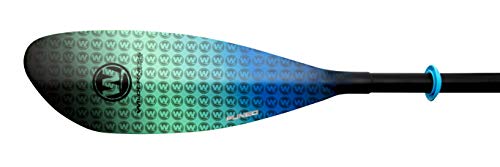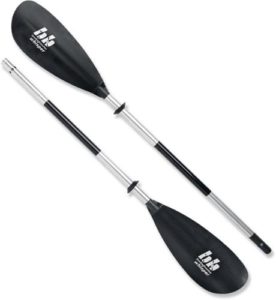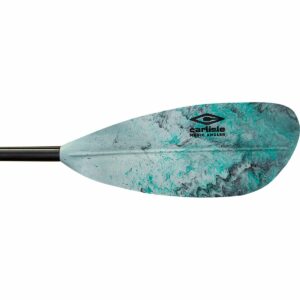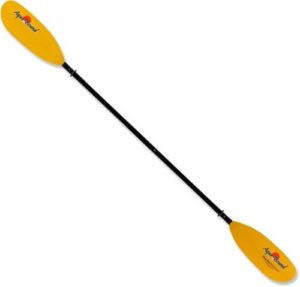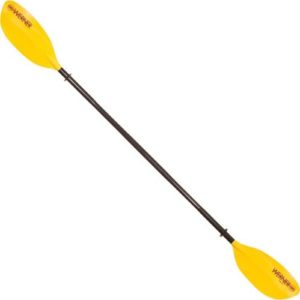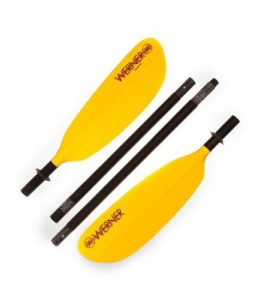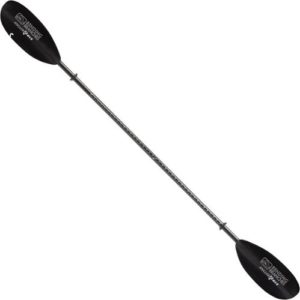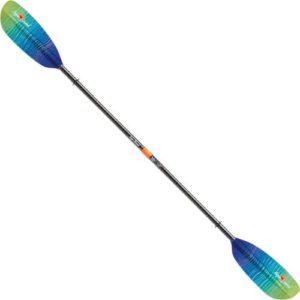There is more to a kayak paddle than meets the eye. There are different paddles designed specifically for different applications and making the right selection will significantly impact your paddling experience. A paddle that’s designed for whitewater paddling, for example, will make casual touring on flatwater much more work than it really needs to be.
In this article, we’re going to review ten of the best kayak paddles and give you the criteria you need to know to select the right paddle for the type of kayaking you’re going to be doing. We’ll also explain many of the features of kayak paddles that you’ll see when you’re searching for a new paddle. Also, don’t forget to check out the current kayak paddles on sale at Gear Snag.
For more of our top kayaking gear recommendations, check out:
Budget Kayak Paddles | Paddles for Beginners
Quick Answer - The Best Kayak Paddles
- Wilderness Systems Pungo
- Bending Branches Whisper
- Werner Kalliste
- Carlisle Paddles Magic Angler
- Werner Cyprus Carbon Bent Shaft
- Aqua-Bound Sting Ray
- Werner Tybee
- Werner Skagit
- Bending Branches Angler Ace Snap
- Aqua-Bound Tango Fiberglass
Comparison Table - Best Kayak Paddle
For the best experience turn your device horizontally| Name | Rating | Price | Weight | Shaft Material | Shaft Type | Blade Surface Area | Review |
|---|---|---|---|---|---|---|---|
| Wilderness Systems Pungo | 4.7 | $$ | 34 oz | Carbon & Fiberglass | 2-piece | 92 square inches | Read Review |
| Bending Branches Whisper | 4.3 | $ | 37 oz | Aluminum | 2-piece | 89 square inches | Read Review |
| Werner Kalliste | 4.7 | $$$ | 23 oz | Carbon Fiber | 2-piece | 99.7 square inches | Read Review |
| Carlisle Paddles Magic Angler | 4.5 | $ | 2 lbs 9 oz | Wrapped fiberglass | 2-piece | Unavailable | Read Review |
| Werner Cyprus Carbon Bent Shaft | 4.6 | $$$ | 1 lb 10 oz | Carbon fiber | 2-piece | 94.5 square inches | Read Review |
| Aqua-Bound Sting Ray | 4.7 | $ | 1 lb 14.5 oz | Carbon | 2-piece | 91 square inches | Read Review |
| Werner Tybee | 4.8 | $$ | 36 oz | Fiberglass-Carbon Blend | 2-piece | 94.25 square inches | Read Review |
| Werner Skagit | 4.6 | $$ | 39 oz | Premium Carbon | 4-piece | 93.75 square inches | Read Review |
| Bending Branches Angler Ace Snap | 4.6 | $$ | 30 oz | Carbon Fiber | 2-piece | 105 square inches | Read Review |
| Aqua-Bound Tango Fiberglass | 4.8 | $$$ | 26 oz | Carbon Fiber | 2-piece | 96 square inches | Read Review |
| Name | Rating | Price | Weight | Shaft Material | Shaft Type | Blade Surface Area | Review |
Reviews - The Best Paddle for Kayaking
Wilderness Systems Pungo
Specs
- Weight: 34 oz
- Shaft Material: Carbon & Fiberglass
- Shaft Type: 2-piece
- Blade Surface Area: 92 square inches
Features
- Adjustable size - 220cm base length expandable up to 240cm
- Two-piece construction breaks down for easy transportation and storage
- Durable fiberglass composite blade
TOP OVERALL KAYAK PADDLE
If you’re in search of a paddle that performs exceptionally and is durable, too, look no further than the Pungo.
This two piece paddle is made of half carbon and half fiberglass, which helps to keep it lightweight while retaining strength through the shaft. An innovative locking mechanism holds the separate paddle pieces together snug enough that there is no play, but easy enough even with limited dexterity. Although it’s not the lightest paddle out there, it weighs in at only 970 grams. The fiberglass blades move light and smoothly through the water but are equally sturdy enough for pushing off gravel banks.
What I like most about this paddle is how easy it is to adjust, allowing you to dial in the perfect fit for every situation.
Bending Branches Whisper
Specs
- Weight: 37 oz
- Shaft Material: Aluminum
- Shaft Type: 2-piece
- Blade Surface Area: 89 square inches
Features
- Comes with heavy-duty rubber drip rings
- Feathering is adjustable to 0 or 60 degrees, with left or right hand control
- Dihedral curve and asymmetrical power face eliminate blade flutter; thin and low-profile to reduce wind resistance
- Lightweight, strong aluminum shaft has 3M Versafit™ over the oval grip area for comfortable and confident hand control
BEST FOR: PADDLERS ON A BUDGET
Looking for a quality beginner kayak paddle for a price you can’t beat, listen close for the Whisper.
This aluminum two piece paddle is ideal for learning proper paddling technique and comes in a lightweight package. The shaft has ovalized grips with a versafit coating to ensure you maintain great grip at all times. A durable nylon blade moves through the water without fluttering, so you can paddle farther with ease.
What I like most about the Whisper are the beefy drip rings that keeps the water from pouring into your lap.
Werner Kalliste
Specs
- Weight: 23 oz
- Shaft Material: Carbon Fiber
- Shaft Type: 2-piece
- Blade Surface Area: 99.7 square inches
Features
- Flexible, Carbon Fiber Shaft (for better performance)
- Adjustable Feathering System (for adapting to your paddling technique)
- Foam-Core Blades (for added buoyancy and lighter stroke)
- Ribless Blade Design (for smoother strokes)
BEST FOR: LIGHT AND BUOYANT STROKES
The Werner Kalliste is the lightest kayak paddle on our list. If you’re looking for a paddle that you’ll hardly feel out on the water, the Kalliste is an excellent choice. This paddle’s flexible carbon fiber shaft is designed to perform better than the competition and the adjustable feathering system will adapt as your paddling technique changes over time. Foam core blades with a ribless back make this paddle more buoyant and, overall, easier to paddle than any of its competitors.
Carlisle Paddles Magic Angler
Specs
- Weight: 2 lbs 9 oz
- Shaft Material: Wrapped fiberglass
- Shaft Type: 2-piece
- Blade Surface Area: Unavailable
Features
- Fiberglass shaft and blade withstand rocky impacts
- Blade cutout frees snagged lines and hooks
- Two-piece push-button shaft separates for easy packing
- Three-way adjusting ferrule allows 0- and 60-degree feathering
BEST FOR: KAYAK FISHING
This is an affordable paddle that can handle the rigors of getting you to your favorite fishing hole.
Carlisle has been making paddle for over 30 years and it shows in the Angler. This paddle is manufactured with a wrapped fiberglass shaft that is comfortable to hold in any temperature. The reinforced asymmetrical blades have a slight curvature, which helps propel you through the water with ease, but can also handle the occasional bump. What sets this paddle apart for anglers in particular are features like the J-hook – located in the blade and intended for removing snags – as well as the ruler in the shaft designed for measuring your catch.
What I like most about this paddle is that Carlisle has added longer shafts to their lineup to accommodate wider boats for fishing.
Werner Cyprus Carbon Bent Shaft
Specs
- Weight: 1 lb 10 oz
- Shaft Material: Carbon fiber
- Shaft Type: 2-piece
- Blade Surface Area: 94.5 square inches
Features
- Adjustment of feathering angle from 0° - 60° right or left in 15° increments
- Low-profile button release makes paddle feel like 1 piece
- Carbon fiber/foam core blades create a distinctive profile that enters and exits the water quietly while adding buoyancy for a light stroke
- Bent shaft naturally aligns wrists, providing immediate comfort and reducing strain
BEST FOR: WHITEWATER MISSIONS
When you need swift powerful strokes to get you through your next rapid, look to the Cyprus Carbon – it was made for the job.
This extremely lightweight paddle features a bent carbon shaft that optimizes paddle control while reducing strain on the wrists. The foam core blades feel light in the water and the spineless back allows you to remove the blade with ease. The mid size asymmetrical blades are designed with power and precision in mind but are not awful to paddle on longer trips too. An adjustable ferrule system allows you to precisely feather the blades as needed in 15 degree increments.
What I like most about the Cyprus Carbon is it is handcrafted in Washington.
Aqua-Bound Sting Ray
Specs
- Weight: 1 lb 14.5 oz
- Shaft Material: Carbon
- Shaft Type: 2-piece
- Blade Surface Area: 91 square inches
Features
- Comfortable Shaft Design
- Reinforced Blades (for added durability)
- Precision Balanced (for better performance)
- Collapsible, 4-piece Design (for more compact storage)
BEST FOR: RECREATIONAL TO LIGHT TOURING
The Aqua-Bound Sting Ray carbon kayak paddle is the perfect choice if you’re a recreational kayaker who enjoys light touring in calm waters. The paddle’s lightweight but durable design is comfortable in your hands and the reinforced blades are made to withstand pushing off any rocks or other objects in your way on the water. This paddle has been precision balanced to improve its responsiveness and performance. It is also a two-piece paddle that can be collapsed and stored in your car without taking up too much space.
Werner Tybee
Specs
- Weight: 36 oz
- Shaft Material: Fiberglass-Carbon Blend
- Shaft Type: 2-piece
- Blade Surface Area: 94.25 square inches
Features
- Flexible Paddle Design (increases comfort and reduces strain)
- Adjustable Feathering System (for better left or right hand control)
- Fiberglass-Reinforced Blades (for lighter weight)
- Asymmetrical Blades (reduces torque and need to grip paddle tightly)
BEST FOR: AGGRESSIVE PERFORMANCE IN AN AFFORDABLE PACKAGE
This kayak paddle is designed to perform in more aggressive paddling conditions without breaking the bank to get that type of performance. The creators of this paddle combined fiberglass and carbon to make a flexible paddle that is more comfortable and doesn’t require as much effort. It also has an adjustable feathering system for more variability when the conditions dictate the need for a different blade angle. This paddle’s reinforced blades are lighter but still strong enough to withstand hits against rocks and other boats. The asymmetrical blade design helps to reduce torque and, overall, makes using this paddle much easier on your hands.
Werner Skagit
Specs
- Weight: 39 oz
- Shaft Material: Premium Carbon
- Shaft Type: 4-piece
- Blade Surface Area: 93.75 square inches
Features
- Low-Angle Blades (easier for paddlers of all sizes and experience levels to use)
- Stable Blade Shape (for smoother performance)
- Lightweight, Durable Blades
- Adjustable For Precise Fitting
BEST FOR: FITTING A WIDE RANGE OF PADDLERS
This four-piece kayak paddle is a great option if you need it to adapt to a variety of paddlers. The precision design allows this paddle to be adjusted to fit many paddlers and the lightweight blades make it easy to use for beginners and experienced paddlers alike. The durable design allows this paddle to withstand hits against rocks and other boats. The low-angle blades also make this paddle easy to handle and the blade shape makes for a smoother, more stable paddling experience.
Bending Branches Angler Ace Snap
Specs
- Weight: 30 oz
- Shaft Material: Carbon Fiber
- Shaft Type: 2-piece
- Blade Surface Area: 105 square inches
Features
- Carbon-Reinforced Blades (for lighter weight and better durability)
- Adjustable Feathering System (for different paddle angles)
- Oversized Paddle Blades (for more power)
- Built-In Tape Measurer On Shaft (for measuring your catch!)
BEST FOR: DISCERNING ANGLERS
This kayak paddle is a great choice for you if you’re an experienced angler who likes to cover a lot of ground on each fishing expedition. The paddle’s reinforced blades can take a beating but don’t add a ton of weight to the overall feel of the paddle. The angle of the paddle blades can easily be adjusted to your liking and the oversized blades make it easier to generate power more quickly. Once you’ve hauled in your catch, you can use the built-in tape measurer on the paddle shaft to measure its size.
Aqua-Bound Tango Fiberglass
Specs
- Weight: 26 oz
- Shaft Material: Carbon Fiber
- Shaft Type: 2-piece
- Blade Surface Area: 96 square inches
Features
- Fiberglass Blades (to save weight)
- Lightweight Paddle Shaft (for effortless paddling)
- Two-Button Release System (for easy breakdown)
- Rubber Drip Rings (to keep your lap dry)
BEST FOR: LIGHTWEIGHT PADDLING
The Aqua-Bound Tango Fiberglass 2-piece kayak paddle is the second-lightest paddle on our list, which makes it the best choice if weight is your primary concern. The paddle’s fiberglass blades and carbon fiber shaft help to make it a lightweight option that doesn’t sacrifice on durability. A simple two-button release system makes this paddle easy to break down and store in a compact space while rubber drip rings keep water from falling into your lap while you’re out on the water.
THINGS TO CONSIDER WHEN BUYING A KAYAK PADDLE
SIZING
Picking the right size for your kayak paddle is largely a consideration of your body stature and the nature of paddling you intend to do. The first measurement you’ll need is your torso length. This is measured by tracing the tops of your Iliac crest (hip bones) around to your spine. Then, measure from there up to the bony prominence at the back of your neck (generally the last of the cervical vertebrae in your spine).
Once you have this number, you’ll be able to determine the general range of paddle length you’re looking for. Keep in mind that every manufacturer has different recommendations for paddle sizing, so be careful to look at the sizing guide for each brand before settling on the length that’s correct for you. If you’re looking for a general sizing guide, REI has a great one here.
The other factor to consider is your paddling style, or the nature of paddling you intend to do. In general, this can be broken down into high-angle and low-angle paddling. Low-angle paddling is what you’ll typically be doing on flatwater such as lakes, ponds, and slow-moving rivers. High-angle paddling is what you’ll be doing if you plan on doing more whitewater or ocean kayaking.
Generally speaking, you’ll want to get yourself a slightly longer paddle if you’re mostly going to be doing low-angle paddling. This will make it easier to generate power without leaning or lifting the opposing blade too high in the air. On the contrary, high-angle paddlers usually gravitate towards shorter paddles because it makes it easier to get another blade into the water on the other side of their kayak when they’re moving quickly through swiftwater.
BLADE MATERIALS
For our purposes, we’re going to focus on the pros and cons of the following blade construction materials: plastic and/or nylon, fiberglass, and carbon fiber.
Plastic/Nylon
The major advantage of buying a kayak paddle with plastic or nylon blades is price. These are going to be the most affordable paddles. However, plastic or nylon blades are more susceptible to cracking and deteriorate more quickly when exposed to sunlight.
Fiberglass
Fiberglass blades perform very well and are more durable than plastic or nylon. Paddles with fiberglass blades are going to be in the middle of the spectrum in terms of price and they are going to weigh less than plastic blades. Rigid fiberglass blades also perform more efficiently in the water.
Carbon Fiber
If you really want the best performance out there, you can’t beat a paddle with carbon fiber blades. These are going to be the lightest paddles on the market and their extra rigidity makes for excellent energy transfer. However, these paddles are by far the most expensive on the market today.
SHAFT MATERIALS
Although some of the most affordable paddles out there have plastic shafts, this is increasingly rare. More commonly, you’ll find aluminum used in the paddles that fall on the lower end of the pricing scale. Aluminum will stand up to the rigors of paddling and provide good performance, but will tend to heat up or cool down more than other materials.
The best kayak paddles have either fiberglass or carbon fiber shafts. They are durable, strong, and, most importantly, very lightweight. Some of the paddles in the medium price range actually offer a blend of fiberglass and carbon fiber in the paddle shaft design.
FEATURES EXPLAINED
PADDLE SHAFT
The paddle shaft is where you hold your kayak paddle. It is the aluminum, fiberglass, or carbon fiber rod that connects the two blades and where the drip rings are located.
PADDLE BLADES
The paddle blades are located at either end of the paddle shaft. These are what you’ll use to generate power while sitting in your kayak. Most paddle blades are curved and are designed to scoop water with every stroke to push your kayak forward. In general, the concave side of the paddle blade should be facing you as you’re sitting in your kayak.
DRIP RINGS
Drip rings are usually made of rubber and they go around the paddle shaft. They should be placed outside of your hands (or between your hands and the paddle blades). When you lift one blade into the air (after it has been in the water), water will fall towards your hands. The drip rings catch a large percentage of this water and make it fall back down into the lake or river you’re paddling on before it falls in your lap.
FEATHERING
The blades of a kayak paddle can be matched at the same angle. They can also be feathered so that they are at different angles when you’re holding your paddle in a neutral position. When blades are feathered (at different angles), it reduces wind resistance on the blade that is out of the water. All of the best kayak paddles can be adjusted to be matched or feathered. Most feathering systems are adjustable at 15-degree increments.
LEFT OR RIGHT-HAND CONTROL
This refers to which hand is used to rotate the paddle when the blades are feathered. The paddles included in this list allow you to adjust the feathering angles for either left or right-hand control.
READ MORE
For more of our top kayaking gear recommendations, check out these popular buyer's guides:

